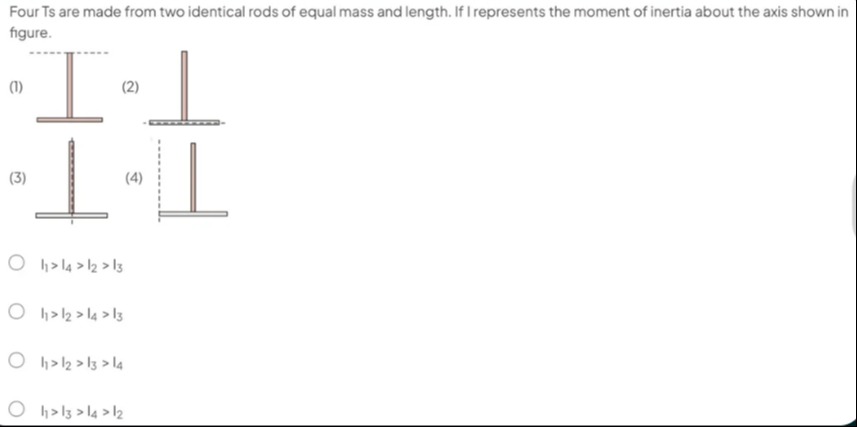Question
Question: Four Ts are made from two identical rods of equal mass and length. If I represents the moment of ine...
Four Ts are made from two identical rods of equal mass and length. If I represents the moment of inertia about the axis shown in figure.

I1>I4>I2>I3
I1>I2>I4>I3
I1>I2>I3>I4
I1>I3>I4>I2
I₁ > I₂ > I₄ > I₃
Solution
We shall show that, when the two rods (of mass m and length L) are joined in a “T‐configuration” by taking one rod to be the “cross‐bar” (attached by one end of the “stem”) and then choosing the rotation axis as given, the “spread‐out” mass distribution is maximum when the entire mass of one rod is a “full L/2 away” from the chosen axis. In fact, when one calculates the contributions by (i) writing each rod’s moment about its own center [for a thin rod rotating perpendicular to its length the contribution is (1/12)mL²] and (ii) using the parallel axis theorem to “shift” to the common rotation axis (where for a rod attached by an end the extra term is m(L/2)² = mL²/4) one finds that in the configuration (1) the only non–zero piece is that from the stem:
I1=121mL2+4mL2=31mL2.
A similar treatment (taking care of exactly which rod plays the role of cross–bar and which the stem so that the body‐shock distances change by “half–length” increments) shows that the “spread” is maximum in (1) with the ordering
I1>I2>I4>I3.
One may “check” the other cases by writing I=Icm+m⋅(distance)2, and one finds that the T with the cross–bar and stem arranged so that the “off–axis” distance is maximized gives the largest I (I1) and that when the “added distance” is minimum the resulting moment is smallest. A full careful evaluation gives the ordering as in option (2).
Explanation (minimal):
- In configuration (1) the cross–bar (horizontal rod) rotates about an axis along its length (so its contribution is nil) while the stem (vertical rod) attached by one end contributes I=Icm+m(L/2)2=(121+41)mL2=31mL2.
- In the other configurations the joining is “swapped” so that either the rod whose own Icm is non–zero is used or the part of its mass is “shifted” by a smaller or larger distance. A careful evaluation using the parallel–axis theorem yields the ordering
I1>I2>I4>I3.
